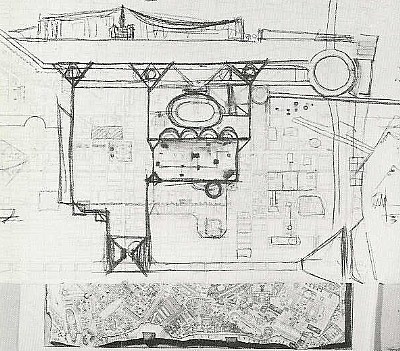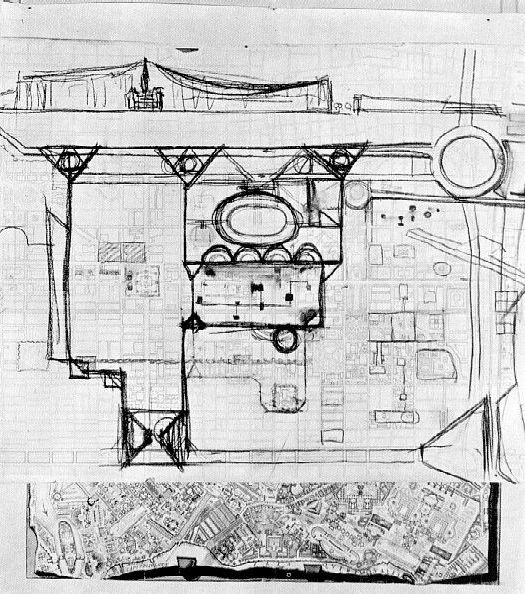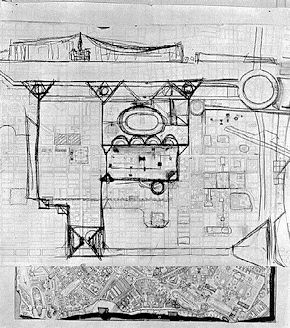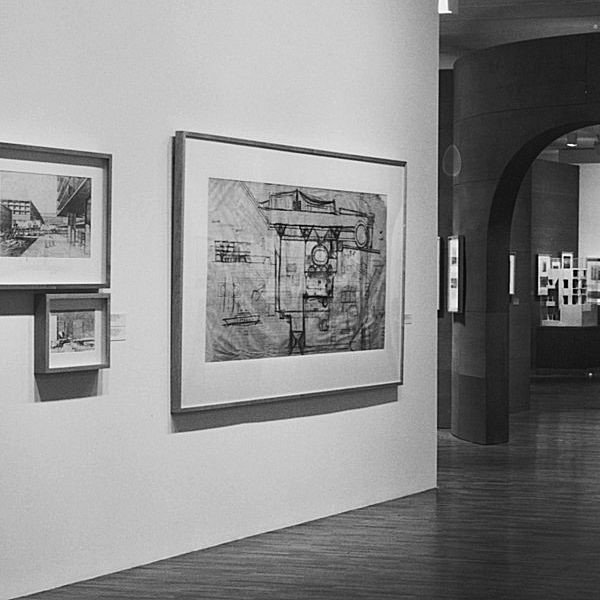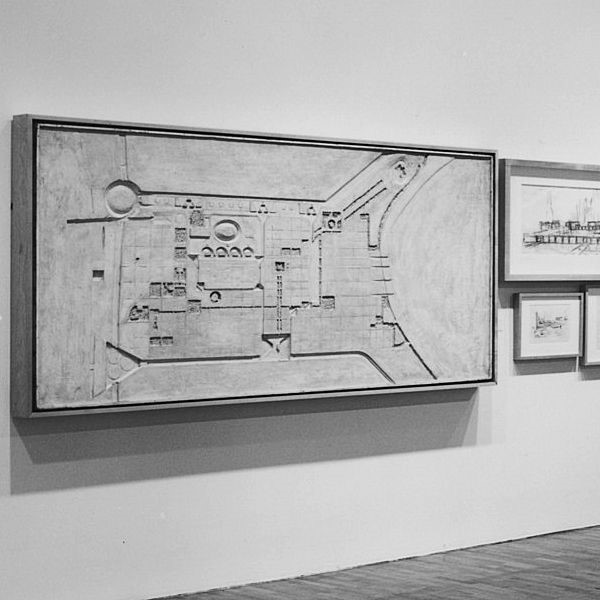| |
2014.02.18 19:01
18 February
Last night I read all of the 27 indexed citings of Kahn, L. within Tafuri's Theories and History of Architecture (1976), and [wouldn't it be neat when all texts are availble as ebooks you could then customize the order of the texts by order of index because] a somewhat revealing subtext manifest itself, like a strong, contiguous thread of thought came more and more into full focus. This will be further analyzed once all the passages are compiled and pieced 'chronologically' together.
This morning I read (again) a good bit of Biraghi's "Kahn as Destroyer" which begins with an analysis/interpretation of Tafuri's first published critique of Kahn's work--"Storicita di Louis Kahn" (1964)--which, from what I can gather, is a critique of Kahn's work via a review of Vincent Scully's Louis I. Kahn. One would hope that Tafuri could read English, but there was certainly nothing stopping him from scrutinizing all the numerous images that chronical Kahn's work up to that point along with some examples of historical context and/or inspiration. Thus, while looking at the images within Scully's Louis I. Kahn now, and at the same time being well aware of Tafuri's writings on Kahn, you can see what is the greater inspiration behind Tafuri's whole critique of contemporary architecture and 'history', even to the point where it was indeed Kahn that lead Tafuri to his 'analysis' of Piranesi's Campo Marzio. I'm still in the process of absorbing all this myself, but it turns out Kahn wasn't the 'destroyer', rather he was the inspiration to Tafuri's counterpoint. Basically, without Kahn the counterpoint would never have happened.
Two images of Piranesi's Campo Marzio appear within Scully's Louis I. Kahn: first the plan on its own, and second the plan with a Kahn sketch of Market Street East Redevelopment Project hanging over it.
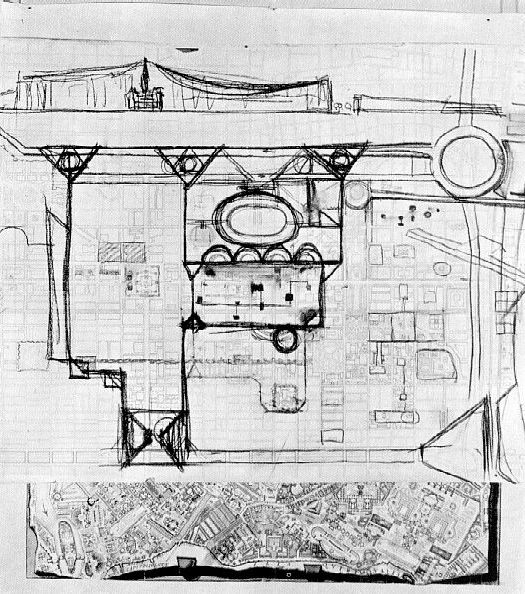
"More directly, the shapes used by Kahn can be found not only in Choisy but also infinitely repeated in the composite photostat of Giovanni Battista Piranesi's map of Rome, drawn by him for his book on the Campus Martius, probably of 1762, which now hangs in front of Kahn's desk."
Vincent Scully, Jr., Louis I. Kahn (New York: George Braziller, Inc., 1962). p. 37.
Tafuri first presented the paper "Giovan Battista Piranesi. L'Architettura come 'utopia negativa' in 1970.
| |
2014.02.21 18:32
21 February
The last mention of Louis Kahn within Tafuri's Theories and History of Architecture (1968) occurs on page 231, just six pages short of the textual end of the book:
"...let us try to re-state our initial proposition: criticism sets limitations to the ambiguity of architecture.
This means that the historian has to oppose the 'camouflaged anti-historicism' of present architecture. By writing past events into a field of meanings, the historian gives sense to the ambiguity of history: from abstract and completely available the ambiguity is rendered concrete and instrumentalizable. He will refuse to read in late-Antique architecture the premises of Kahn or Wright, in Mannerism those of Expressionism or of the present moment, in the pre-historical remains the premises of organicism and of some abstract experiences. And this refusal is a precise contestation of the mythologies of the pseudo-avant-garde."
As already cited earlier in the book, "late-Antique architecture" is short-hand for Hadrian's Villa and Piazza Armerina--"many late-Antique architectures from Villa Adriana to Piazza Armerina" (p. 110)--but it is also a veiled reference to Piranesi's Ichnographia Campus Martius:
"The disarticulation of the spatial successions, in the Villa Adriana or in the Piazza Armerina, are so coherent with the premises that justify them--the test of the autonomy range of the single spatial fragment, modulated, contracted or made elastic, to emphasize its absoluteness and to increase its ambiguity within the entire context--as to make these works a sort of anthology, not only for successive studies, but also as sources to draw from: not by chance was a whole number of Perspecta taken up by the Villa Adriana [sic], and Kahn often showed his interest for this singular group of architectural objects.
What is of value in those exceptional late-antique monuments is the series of differentiated spaces that join and clash with one another: Piranesi's Campo Marzio, that owes so much to the study of the Villa Adriana, takes to the limit its formal bricolage, moving its search for a semantic polyvalency to another scale and to another historical context." (p. 113)
It's not clear why Tafuri considers Hadrian's Villa as an example of late antique architecture, since it was built almost two centuries before what is considered the late antique period. The Piazza Armerina is late antique, even possibly connected to Maximian and Eutropia, and it is quite possible that Tafuri uses the Paizza Armerina as an historiographical link between Hadrian's Villa and Piranesi's Ichnographia Campus Martius.
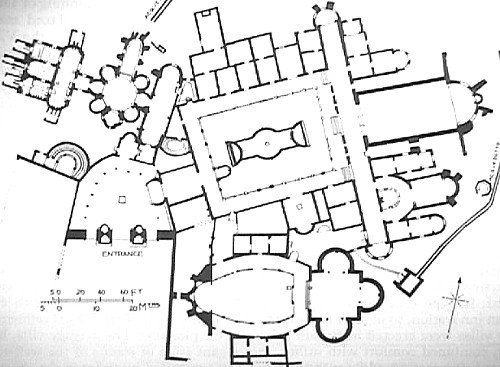
So, in re-phrasing Tafuri's last mention of Kahn within Theories and History of Architecture we have:
"He [the historian] will refuse to read in [the] architecture [of Hadrian's Villa, the Piazza Armerina, and of Piranesi's Campo Marzio] the premises of Kahn or Wright..."
Tafuri's "refusal to read" is a direct rebuttal to a key passage within Vincent Scully's Louis I. Kahn (1962):
"Not so in the studies between the laboratories; their problem demanded a more complicated sequence of Form and Design, and its solution was again characteristic of Kahn. Early shapes used were pure derivations from the fanning pattern of the lower peristyle of Domitian's palace on the Palatine or from the "Teatro Marittimo" of Hadrian's Villa. It will be recalled that Wright had long before adapted the plan of the Villa as a whole for his Florida Southern College of 1939, and had used shapes from or related to it in later projects, while Le Corbusier had supplemented his sculptural Hellenic impulses with a series of drawings of the Villa's spaces which culminated in his top-lit megara at Ronchamp. More directly, the shapes used by Kahn can be found not only in Choisy but also infinitely repeated in the composite photostat of Giovanni Battista Piranesi's maps of Rome, drawn by him for his book on the Campus Martius, probably of 1762, which now hangs in front of Kahn's desk. Nervi, too, has used this curvilinear pattern in some of his ribbed slabs. Kahn had intended to support the studies on columns which arose from the associated garden at the lower level to grasp them about at the thirds of their arcs; but a further stage of Design intervened: the scientists could not see the sea from these shapes. Thus they were modified and the present simpler forms grew out of them.
Patterns from Rome and, most particularly, from Ancient Rome as imagined by Piranesi at the very beginning of the modern age, have played a part in the process at the Meeting House as well . An early sketch had been traced by a draftsman, partly as a joke, from a plan of one of the units of Hadrian's Villa itself. "That's it," said Kahn." (p. 37)
I never before imagined the prospect of considering Tafuri's Theories and History of Architecture a deliberate deterritorialization of the Philadelphia School.
|
